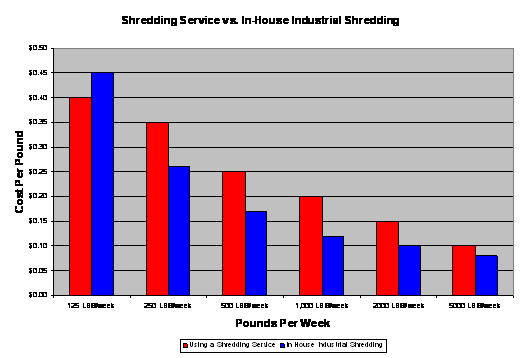Industrial Shredder FAQWhat’s an Industrial Shredder?Industrial shredders are conveyor fed shredders designed for higher volumes applications. Instead of feeding sheets into a slot, your just toss piles of sheets on to the conveyor and the conveyor feeds the piles of paper into large, hardened steel cutting heads. Industrial shredders can work as stand alone units or with integrated balers.Is an industrial shredder right for my company?Industrial shredders allow you to do for yourself what you normally hire a shredding service to do, which is to reduce the cost of shredding by consolidating the shredding of numerous employees, using a high capacity shredder. This allows the bulk of shredding to be done by one, lower cost employee (lower as compared to your expensive office workers, administrators and even managers) and therefore reduce the overall cost of shredding. You can begin to cost justify an industrial shredder at about 500 pounds of shredding per week. The more shredding your company does, the more cost effective an industrial shredder becomes.How much can an industrial shredder shred per hour?Industrial shredders can shred from 750 to about 2,250 pounds of paper per hour, depending on the cut type. Seven hundred fifty pounds of paper would be about 15 large file boxes of paper, file folders, mail and other items commonly shredded. Each file box will typically weigh about 50 pound when full, so 2,250 pounds would be about 45 large file boxes.How can I estimate how much shredding my company does?One method is by number of employees. The average office worker in the US shreds about 50 sheets of paper per day. This includes self generated documents, incoming mail and items purged from filing cabinets. This translates into about 2.5 pounds of shredding per employee, per week. So a typical company with 250 office workers on site will probably shred about 625 pounds per week.Another method is to count the number of shred boxes and bins in use and multiply as appropriate by the capacity of each type of box or bin. The most common shred box sizes are the 36” and 27” boxes which hold 65 and 45 pounds of paper respectively. The most popular bin sizes are the 92 and 64 gallon bins which hold 350 and 250 pounds respectively. Is it less expensive to use an industrial shredder, or to hire a shredding service?Your price from a shredding service will depend on a few factors:1. Your shredding volume, the higher the volume, the lower the unit cost. Shredding services will typically price by the bin (sometimes called “by the tip”) or they will charge by the minute/hour. Some services also charge for pick-up (also called “visit charges”). There may also be unanticipated costs such as fuel surcharges when fuel prices go up. Prices are also affected by the after market price the shredding service can get for the paper they sell to recycling companies. You’ll probably find that the going price of shredding services will equate to about twenty to twenty-five cents per pound although few if any shredding service will actually quote a “per pound” price. High volumes may equate to as low as ten cents per pound and lower volumes can equate to as much as forty cents per pound. Your cost to shred in-house with an industrial shredder will also depend on three factors: 1. The hourly labor rate of the person you designate to do the shredding. Fortunately, all of these costs are easily anticipated and can be controlled with an effective security plan. The chart below illustrates the relative cost per pound of both, at varying levels of shredding volume.  The operative point is that by installing your own industrial shredder, buying your own bins and developing your own plan, you are essentially employing the same logic and economy of scale that the shredding service uses and you keep the savings. What do I need, to put my own in-house shredding plan together?There are a few things you will need to arrange:1. Does your facility have the space for an in-house industrial shredder? You will need: a. space for the shredder (shredder footprint plus about 3-4 feet all around) 2. Does your facility have, or can you install adequate power at the location where shredding will take place. You will need 220V, 3-phase, 30 or 50 amp, 60 cycle power. 3. Do you have, or can you hire a low cost, reliable employee to do the shredding? This is a great job for a high school student as you will find that because of the capacity of the shredder, the shredding can be done once or twice a week. 4. You will need to purchase shred boxes and/or bins and wheeled carts to transport the material from the boxes and bins to the shredder. Shred boxes and bins are inexpensive and long lasting. There are several quality manufacturers. What are some of the elements that my plan should contain?
How many shred boxes, bins and shredders will I need?Logistics will play a significant role in this decision because in addition to considering the number of employees that will be serviced by a box, bin or shredder, you need to consider access. You also need to consider the probability of a given department to produce documents that should be shredded. These things considered, here are a few very general guidelines:
|